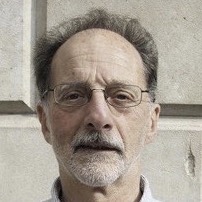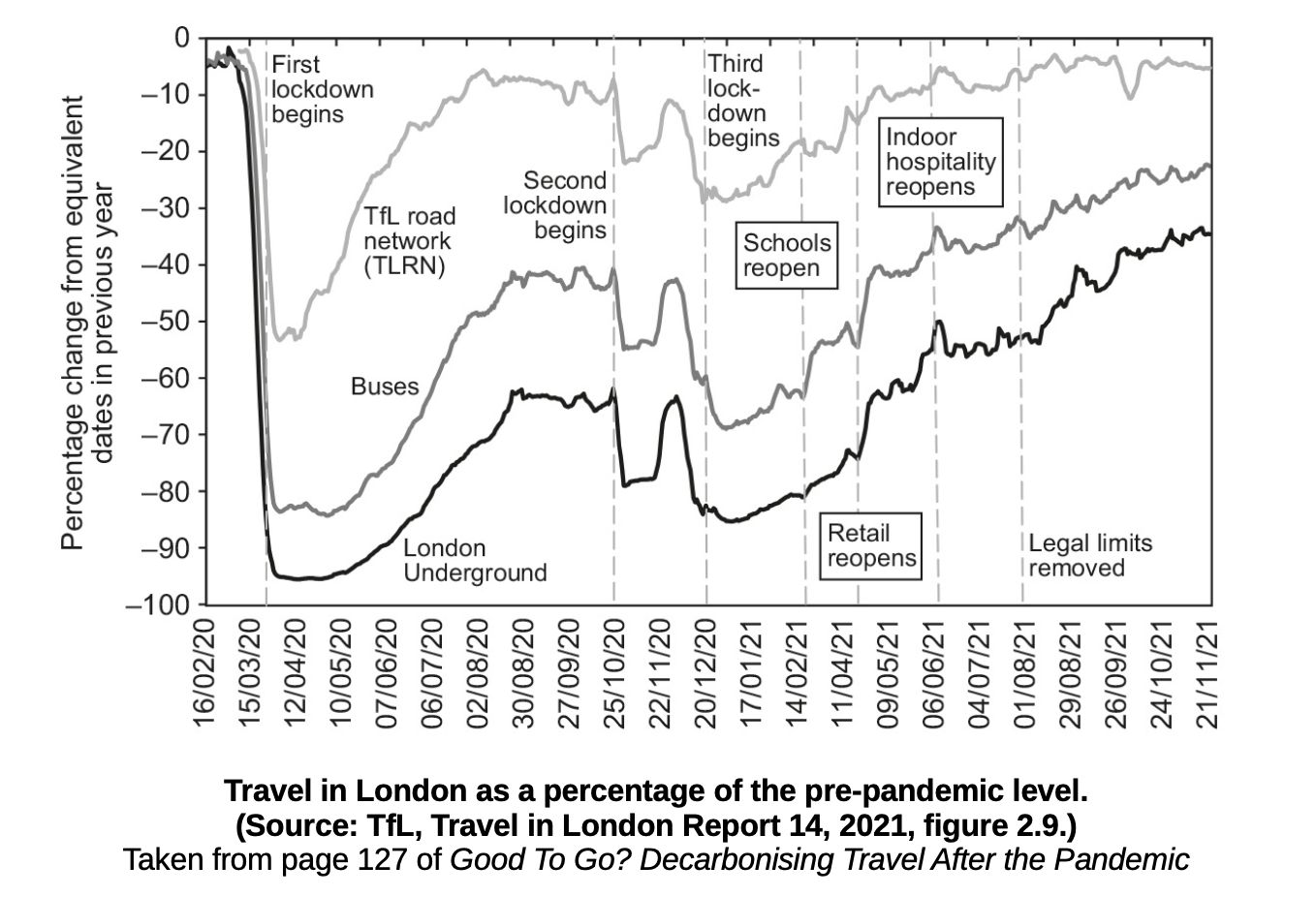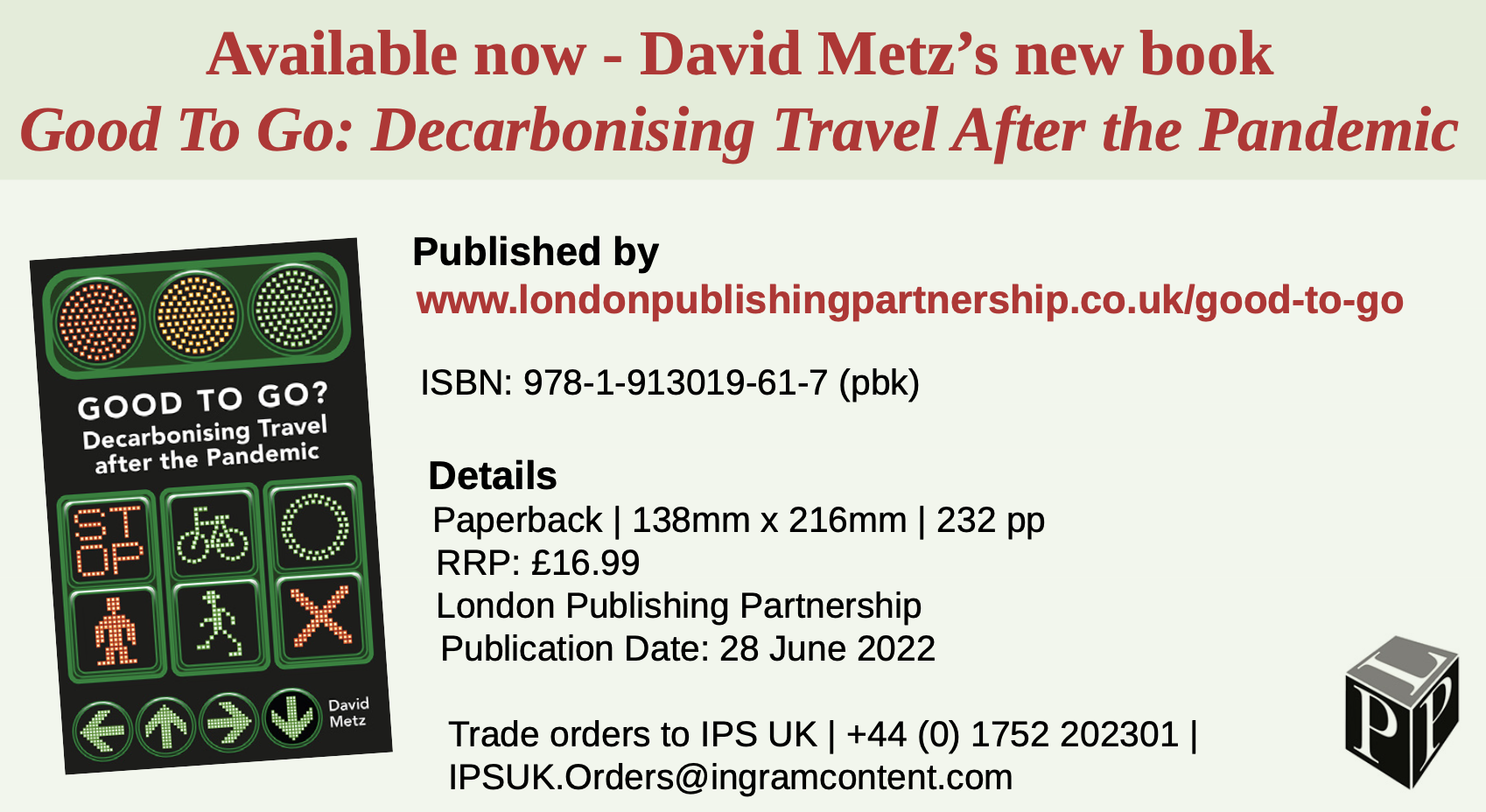TAPAS.network | 25 July 2022 | Commentary | David Metz
Are we good to go? Decarbonising Travel After the Pandemic

The great challenge for our times is to bring to an end the emission of the greenhouse gases that are the cause of global warming and this means we must replace the fossil fuels that are the basis of our modern civilisation says . His new book - Good To Go? Decarbonising Travel After the Pandemic - assesses the implications for travel, and he outlines its proposition here.
TRAVEL IS CENTRAL to our lives, and the transport system brings us the goods and services that we need and allows us to access the experiences and opportunities that we seek. Yet our transport system is far from future proof and has many endemic problems: noise, air pollution and carbon emissions, deaths and injuries, and the intrusion of vehicles into unsuitable locations. Much effort and money has been devoted to tackling these problems, over many years, but progress is slow.
Now the overriding urgent need to respond to climate change is prompting a switch to net zero power systems, particularly electric vehicles – and a recognition that the amount of travel we undertake will need to be reduced. The coronavirus pandemic caused a great shock to our travel patterns, showing us that we could manage with much less movement if we had to. But as the pandemic recedes, our travel behaviour is largely reverting to what it was before, albeit with less commuting to work and less shopping in person.
I thought it time to attempt a comprehensive overview of the transport system, how it has developed over time and in the light of recent significant new influences, and how it will need to further evolve to meet our need for travel sustainably and economically – and at what are our best options for meeting those needs. That’s the premise of my new book Good To Go? Decarbonising Travel After the Pandemic.
The experience of the Covid-19 pandemic showed that we could make radical changes to our travel behaviour, but regrettably, little of this is sticking now that the restrictions have been lifted. We are a year into the Department for Transport’s Transport Decarbonisation Plan, intended as a key sectoral contribution to deliver the government’s ambitious climate change objective, but is it embedded and effective as well as aspirational? There also remain many uncertainties about what can be expected from new technologies and about the possibilities for behavioural change that would reduce carbon emissions. My book is intended to be a timely contribution to an ongoing debate in which the imperative of decarbonisation is becoming the dominant consideration in transport policy and practice.
Surface transport is responsible for 22% of the UK’s carbon emissions

So where are we now? Surface transport is responsible for 22% of the UK’s carbon emissions. Electric propulsion is now being rapidly adopted by road transport. No new cars and vans powered solely by petrol or diesel are to be sold after 2030. Other vehicles – goods and public transport – will take rather longer. Substantial efforts are in hand to put in place sufficient electric charging outlets so that range anxiety does not remain an impediment to the purchase of electric vehicles.
Decarbonising air travel is far more problematic, and the industry has been late to address the need. Development of electric propulsion for short range aviation is underway. For longer distances, sustainable biofuels are being trialled and synthetic fuels are a possibility for existing aircraft. Hydrogen may be a feasible fuel for new designs. All these alternatives to kerosene seem likely to be substantially more expensive and so their uptake would need to be forced in some way through regulation.
There remain to be eliminated the carbon emissions from electricity generation, as well as the embedded carbon in the materials employed to construct vehicles and their batteries, and in the maintenance and expansion of transport infrastructure. The implication of reaching the objective of Net Zero by 2050 is that this will be achieved. Yet there must be considerable uncertainty about such techno-optimistic scenarios.
Past experience of technological innovation provides some comfort that needed innovations can be developed and deployed speedily. Recently, we had the Covid vaccines, offshore wind, low-cost solar power, Tesla’s electric car. During the Second World War we had the jet engine, radar, V2 rocket, atomic bomb, and after the War, nuclear power for electricity generation.
The incentives to develop decarbonising technologies are strong, both for commercial success and scientific fame, and there are enormous efforts underway, ranging from new micro mobility concepts to innovative designs for nuclear fusion reactors. Yet the uncertainties associated with technological development are great, particularly when we are up against a deadline dictated by the need to halt climate change. This prompts many analysts and commentators to argue that substantial changes in travel behaviour will also be needed if the government’s stated objective is to be achieved - reducing emissions by 78% by 2035, compared with 1990, consistent with limiting warming to 1.5C.
Notably, the Climate Change Committee, the government’s official advisor, judged that changed travel behaviour could contribute to a reduction in car use of 7-16% by 2030 and 12-24% by 2050, although in my view it was optimistic about the scope for behaviour change. The Department for Transport is optimistic about the opportunities for increased use of public transport, walking and cycling, wanting to make these the ‘natural first choice for all who can take them’, and is also optimistic about the scope for technological solutions, particularly for air travel.
The coronavirus pandemic demonstrated that many of us could make substantial changes to
how we lived and travelled, impelled by concerns for personal health and government-imposed restrictions. Yet as the pandemic has ebbed, we are largely reverting to our previous travel behaviour, with car use in the lead, followed by leisure air travel, with bus and rail travel not yet back to pre- pandemic usage.
While the long-term consequences of this ‘natural experiment’ to perturb travel behaviour are not yet clear, some increase in working from home and in online shopping seem likely. Yet it must be doubted whether this will lead to an overall reduction in travel, given that the average time we spend travelling has held steady about an hour a day for at least fifty years before the pandemic. Some changes in the pattern of travel are certainly possible, particularly as a consequence of more working from home, whether more active travel in the neighbourhood, or more leisure trips by car.
We have become habituated to travel to gain access to people and places, opportunities and choices of employment and services, all of which were quite limited before the era of fossil fuels that powered the railways of the nineteenth century and the cars and planes of the twentieth. The nature of the climate change emergency feels far less pressing than that arising from a threat to our health. For most people there is only limited incentive to cut back on the benefits of access to reduce personal contributions to carbon emissions.
Alternative modes to car travel are widely promoted – active travel and public transport. Yet
the car remains attractive for trips where delays due to road traffic congestion are not excessive
and where there is parking available at both ends of the journey. Even in Copenhagen, famous for its cycling culture, car use is only a little less than in London (public transport mode share is half London’s). Despite all the praiseworthy efforts to boost walking and cycling, and to encourage all forms of shared use of vehicles, the evidence suggests that there is limited scope for shifting mode share away from the present high levels of car use. The best prospects are in densely populated city centres where it is economic to provide public transport of high quality and service frequency, and where road space may be freed up for buses by restricting carriageway for cars parked and in motion. Elsewhere, the attractions of the car should not be underestimated.
What could make a difference to the high share of trips by car would be policy that increased the cost of car use relative to other modes. Yet such shifts in relative costs are unpopular, as well as being inequitable in respect of those with low income who are dependent on the car for essential journeys. Indeed, the introduction of electric vehicles (EVs) with low operating costs is increasing the attractions of the car. There will be a case for some form of road user charging to replace the revenue lost from fuel duty as conventional vehicles are phased out. Most acceptable would be a charge for electric vehicles to be implemented once the capital cost of EVs falls to match that of internal combustion engine vehicles, as is expected over the coming decade.
The debate about the scale of the need for changes in travel behaviour is far from settled. The arguments depend in large part on models that project travel and transport out to 2050. There is as yet no consensus amongst the modellers, not helped by a lack of transparency by the Department for Transport concerning its assumptions about road traffic growth and EV uptake.
So, at present we are faced with uncertainty as to how the demanding objectives for transport decarbonisation are to be achieved:
-
Technological change has much to offer, but we cannot be confident that it will deliver all the emission reductions required.
-
The prospects for behavioural change seem limited in the absence of increased costs of car use.
-
Increasing the costs of car use would be difficult to implement.
What might be done? We need to devise approaches that reduce transport carbon emissions while recognising our need for access made possible by the transport system. Here are three suggestions for possible policies that would contribute to the decarbonisation objective and which could command public support:
-
We stop adding to the capacity of the Strategic Road Network, treating it as a mature system whose operational efficiency can be enhanced through digital technologies. We use the funds freed up to support the government’s Levelling Up objective of improving public transport in the regions.
-
We call a halt to increases in airport capacity. There is plenty of room for business travel to grow if the demand is there, displacing lower value leisure trips.
-
Road user charging for EVs would allow the revenue to be apportioned between national and local government. Local decisions to raise charges could generate revenue to improve public transport.
We also need a better way to identify and discuss policy options. There has been a vast development of mathematical analyses of transport economics and modelling, making simplifying assumptions, yet with disappointing consequences for real world outcomes. We are in danger of missing the wood for the trees, so to speak.
In the final chapter of my book, I propose some heuristics based on experience – mental short cuts, rules of thumb – intended to be helpful for practical decision takers. Let me leave you with this short selection, dealing principally with road traffic congestion. You will find more such suggestions of how we might best think about the way ahead in the book itself.
Time and Space - The two constraints that fix our options
-
Invariant average travel time of an hour a day is unlikely to change in the future (pandemic shocks excepted). This time constraint is important for how travel behaviour changes as the result of changed circumstances.
-
The time constraint limits the growth of traffic congestion. Congestion arises in places where there is high population density and high levels of car ownership, such that there are more trips that might be made by car than there is road capacity available.
-
If traffic volumes increase, so delays increase, and some potential road users make alternative choices, whether a different route or time, or a different mode of travel where there are options, a different destination (shopping at another destination, for instance), or not to travel at all (such as shopping online). A congested equilibrium is established, with gridlock arising only under unexpected conditions such as road works or a motorway pile-up. The scale of congestion depends on what alternatives are available, with urban rail important for limiting traffic congestion in cities.
-
The existence of a congested equilibrium in which some car trips are suppressed by the prospect of unacceptable delays is the reason why measures to mitigate congestion fail. We know from experience that we can’t build our way out of congestion by adding road capacity, because this permits previously suppressed journeys to be undertaken. More capacity allows more trips and traffic, but congestion is not lessened, other than immediately after the opening of new capacity, before the new congested equilibrium is established.
-
Conversely, subtracting road capacity, as happens when cities make more space for buses and bicycles, reduces the volume of traffic without increasing congestion beyond the initial period when road users are adapting to the new delays. So, it is difficult to change the intensity of congestion on roads open to general traffic, but it is possible to change the amount of congestion in an area, either by adding or reducing road capacity, which adds to or reduces the volume of congested traffic.
-
The existence of suppressed car trips limits the impact of other measures to mitigate congestion that are often advocated, including investing in public transport use and active travel, consolidating freight deliveries into fewer vehicles, and congestion charging, as operated in London. Sufficiently high levels of charge for road use could deter sufficient numbers of road users to relieve congestion, but this would likely be problematic for reasons of equity and public acceptability.

David Metz is an honorary professor in the Centre for Transport Studies, University College London, where his research focuses on how demographic, behavioural and technological factors influence travel demand. He spent part of his career as a senior civil servant in a number of UK government departments, both as policy advisor and scientist, including five years as Chief Scientist at the Department of Transport. www.drivingchange.org.uk
This article was first published in LTT magazine, LTT850, 25 July 2022.
You are currently viewing this page as TAPAS Taster user.
To read and make comments on this article you need to register for free as TAPAS Select user and log in.

Log in